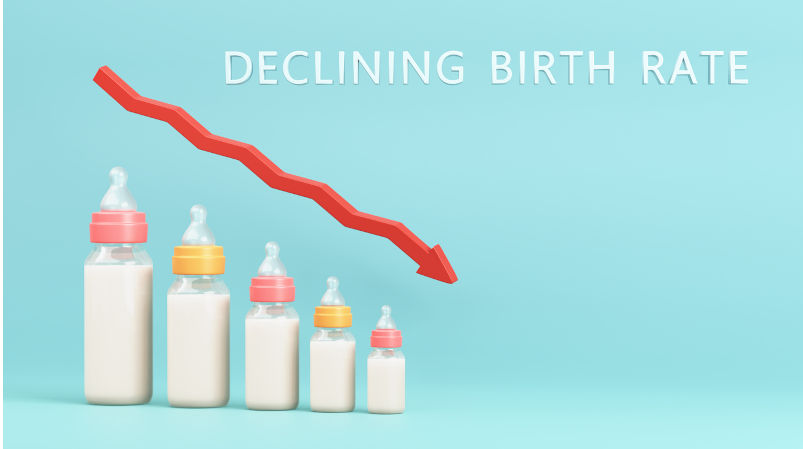Worried about a ‘baby bust’? Then prevent pregnancy ‘wastage’
April 26, 2025
Hardly a day passes without anxiety-laden news stories about falling birth rates across the globe.
These are routinely accompanied by dire warnings about the anticipated long-term economic and societal consequences of too few babies. The main worries are a depleted workforce, reduced consumer spending, inadequate care for the elderly and declining tax revenues.
Even nations at odds with each other are united in decrying this current trend. South Korea has a plan to avoid population collapse, while North Korea may issue punishments to reverse its falling birthrate. Asia is a particular focal point for this panic, but it is echoed across Europe and the other OECD countries, too. For instance, the lowest birth rates in more than 20 years are raising alarms in the UK, US and Australia.
Similarly, the Greek prime minister has called the baby bust a national threat and a “ticking time bomb” and is offering tax breaks, repatriation incentives and cash benefits to address the problem. The Greek Government is far from alone in emphasising economic measures to deal with this demographic dilemma.
And yet, there are two essential realities largely missing from the leading analyses and proposed solutions. The first is a disconnect between pregnancies and babies. The remedies intended to reverse declining birth rates — from more affordable housing to better pay and leave policies — are built on the assumption that people of childbearing potential are increasingly choosing not to become parents. There are, of course, some people whose priorities mitigate against having children. And, for some of them, the remedies being proposed might make a difference in their attitudes and actions.
However, the “choice” assumption blithely ignores the contradictory fact that at least one out of every four pregnancies has an “unhappy ending”. These are pregnancies intended to be full-term, producing healthy babies who will grow up to become net assets to their economies and societies. An “unhappy ending” includes miscarriages, stillbirths, therapeutic terminations, very premature deliveries, harm to the mother’s health and/or her future reproductive life, as well as babies born with lifelong, life-limiting birth defects. There also still remains a significant percentage of unintended, mistimed or unwanted pregnancies.
Turning all “unhappy endings” into happy ones is well beyond our collective capacity. Still, a large proportion of these unwelcome outcomes could, and should, have been prevented through robust, universal, effective policies and practices under the umbrella of preconception and interconception health, education and care.
To cite one of many examples: 80% of the babies born with, and burdened by, neural tube defects could have been prevented from ever developing NTDs by implementing fully effective fortification of staple foods with Vitamin B9 (folic acid) (British Medical Journal feature, 2023). Think about the implications of the rate of “unhappy endings” dropping from one in four to one in 14, or eventually to only one in 40. That alone would eliminate the panic over lower birth rates.
The second flaw in the current remedies is a disregard for quality versus quantity of births. Everyone wants a healthy, productive and thriving citizenry. But we all know this does not happen in reality. Thus, the panic over falling birth rates is predicated, in part, on the belief that the current proportion of any birth cohort who will not become successful net contributors to the economy and society will remain stable.
However, there is no natural law dictating the inevitability of this prediction. What if a significantly higher percentage of babies in each birth cohort is just fine? Think about the implications of preventing (before and during pregnancy) most of the large number of children born with — and hampered for life by — foetal alcohol spectrum disorders. Avoiding preventable harm to babies — from FASD and other conditions — would neutralise many negative impacts of declining birth rates. Moreover, it would do so much more cheaply than the economic measures being considered.
On a more personal note, I am writing this column from the perspective of a “Boomer” (someone born between the mid-1940s and mid-1960s). During my life, I have witnessed the rise and fall of numerous, diametrically opposed, demographic trends predicted to have disastrous impacts. The first was the Malthusian, society-shaking book, The Population Bomb (1968), by Paul and Anne Ehrlich. The baby boom then was a source of anxiety and rapidly falling birth rates across the globe would have been an undiluted Godsend and a dream come true.
Choosing to prevent harm by preparing well for pregnancy — in other words, preconception and interconception health, education and care — could become the silver lining in the present population panic. In fact, this silver lining offers us a golden opportunity. But only if we have the precious “mettle” to finally accord priority in thought, word and deed to promoting healthier pregnancies and better lives.
Thie article was originally published in the International Journal of Birth and Parent Education
References
British Medical Journal Feature (2023) Folic acid: The case to rethink the UK’s food fortification plans. British Medical Journal, 381:1335.
Ehrlich, P. & Ehrlich, A. (1968) The Population Bomb. United States: Sierra Club/Ballantine Books.
